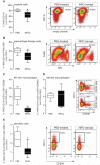Transplanted neural stem/precursor cells instruct phagocytes and reduce secondary tissue damage in the injured spinal cord
- PMID: 22271661
- PMCID: PMC3558737
- DOI: 10.1093/brain/awr339
Transplanted neural stem/precursor cells instruct phagocytes and reduce secondary tissue damage in the injured spinal cord
Abstract
Transplanted neural stem/precursor cells possess peculiar therapeutic plasticity and can simultaneously instruct several therapeutic mechanisms in addition to cell replacement. Here, we interrogated the therapeutic plasticity of neural stem/precursor cells after their focal implantation in the severely contused spinal cord. We injected syngeneic neural stem/precursor cells at the proximal and distal ends of the contused mouse spinal cord and analysed locomotor functions and relevant secondary pathological events in the mice, cell fate of transplanted neural stem/precursor cells, and gene expression and inflammatory cell infiltration at the injured site. We used two different doses of neural stem/precursor cells and two treatment schedules, either subacute (7 days) or early chronic (21 days) neural stem/precursor cell transplantation after the induction of experimental thoracic severe spinal cord injury. Only the subacute transplant of neural stem/precursor cells enhanced the recovery of locomotor functions of mice with spinal cord injury. Transplanted neural stem/precursor cells survived undifferentiated at the level of the peri-lesion environment and established contacts with endogenous phagocytes via cellular-junctional coupling. This was associated with significant modulation of the expression levels of important inflammatory cell transcripts in vivo. Transplanted neural stem/precursor cells skewed the inflammatory cell infiltrate at the injured site by reducing the proportion of 'classically-activated' (M1-like) macrophages, while promoting the healing of the injured cord. We here identify a precise window of opportunity for the treatment of complex spinal cord injuries with therapeutically plastic somatic stem cells, and suggest that neural stem/precursor cells have the ability to re-programme the local inflammatory cell microenvironment from a 'hostile' to an 'instructive' role, thus facilitating the healing or regeneration past the lesion.
Figures







References
-
- Alexander JK, Popovich PG. Neuroinflammation in spinal cord injury: therapeutic targets for neuroprotection and regeneration. Prog Brain Res. 2009;175:125–37. - PubMed
-
- Bacigaluppi M, Pluchino S, Peruzzotti-Jametti L, Kilic E, Kilic U, Salani G, et al. Delayed post-ischaemic neuroprotection following systemic neural stem cell transplantation involves multiple mechanisms. Brain. 2009;132:2239–51. - PubMed
-
- Barnabe-Heider F, Frisen J. Stem cells for spinal cord repair. Cell Stem Cell. 2008;3:16–24. - PubMed
Publication types
MeSH terms
Grants and funding
LinkOut - more resources
Full Text Sources
Other Literature Sources
Medical
Miscellaneous

